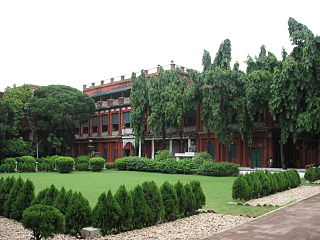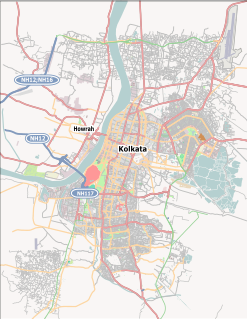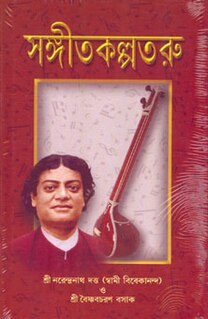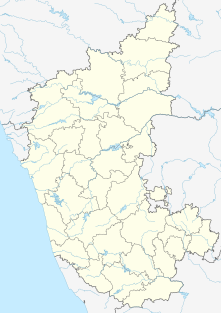
Kalakshetra Foundation, formerly simply Kalakshetra, is an arts and cultural academy dedicated to the preservation of traditional values in Indian art and crafts, especially in the field of Bharatanatyam dance and Gandharvaveda music. Based in Chennai, India, the academy was founded in January 1936 by Rukmini Devi Arundale and her husband George Arundale. Under Arundale's guidance, the institution achieved national and international recognition for its unique style and perfectionism. In 1962, Kalakshetra moved to a new campus in Besant Nagar, Chennai, occupying 40 hectares of land.

Rabindra Bharati University is a university in Kolkata, India. It was founded on May 8, 1962, under the Rabindra Bharati Act of the Government of West Bengal in 1961, to mark the birth centenary of the poet Rabindranath Tagore. It is located at the Tagore family home, Jorasanko Thakur Bari.

Jorasanko Thakur Bari (Bengali: House of the Thakurs in Jorasanko, north of Kolkata, West Bengal, India, is the ancestral home of the Tagore family. It is currently located on the Rabindra Bharati University campus at 6/4 Dwarakanath Tagore Lane Jorasanko, Kolkata 700007. It is the house in which the poet and first non-European Nobel laureate, Rabindranath Tagore was born. It is also the place where he spent most of his childhood and died on 7 August 1941.

The National Gallery of Modern Art (NGMA) is the premier art gallery under Ministry of Culture, Government of India. The main museum at Jaipur House in New Delhi was established on 29 March 1954 by the Government of India, with subsequent branches at Mumbai and Bangalore. Its collection of more than 14,100 works includes works by artists such as Thomas Daniell, Raja Ravi Verma, Abanindranath Tagore, Rabindranath Tagore, Gaganendranath Tagore, Nandalal Bose, Jamini Roy, Amrita Sher-Gil as well as foreign artists, apart from sculptures by various artists. Some of the oldest works preserved here date back to 1857. With 12,000 square meters of exhibition space, the Delhi branch is one of the world's largest modern art museums.

Visva-Bharati University is a public central university located in Santiniketan, West Bengal. It was founded by Rabindranath Tagore who called it Visva-Bharati, which means the communion of the world with India. Until independence it was a college. Soon after independence, in 1951, the institution was given the status of a university and was renamed Visva-Bharati University. The English daily, The Nation, notes, "Using the money he received with his Nobel Prize for Literature in 1913, the school was expanded and renamed Visva-Bharati University. It grew to become one of India's most renowned places of higher learning, with a list of alumni that includes Nobel-winning economist Amartya Sen, globally renowned filmmaker Satyajit Ray and the country's leading art historian R. Siva Kumar, to name just a few."

Rabindra Sadan is a cultural centre and theatre in Kolkata, located near the Nandan cinema and cultural complex and the Academy of Fine Arts on AJC Bose Road in South Kolkata.

Rabindranath Tagore is a 1961 black-and-white short film directed by an Indian director Satyajit Ray on the life and works of noted Bengali author Rabindranath Tagore. Ray started working on the documentary in the beginning of 1958 and it was released during the birth centenary year of Rabindranath Tagore, who was born on 7 May 1861. Ray avoided the controversial aspects of Tagore's life in order to make it as an official portrait of the poet. Though Tagore was known as a poet, Ray did not use any of Tagore's poetry as he was not happy with the English translation and believed that "it would not make the right impression if recited" and people would not consider Tagore "a very great poet", based on those translations. Satyajit Ray has been reported to have said about the documentary Rabindranath Tagore in his biography Satyajit Ray: The Inner Eye by W. Andrew Robinson that, "Ten or twelve minutes of it are among the most moving and powerful things that I have produced".

Patha Bhavana is an institution of primary and secondary education in Santiniketan, West Bengal, India. Founded by Nobel laureate Rabindranath Tagore in 1901, starting with only five students, the school is characterized by its philosophy of learning with the heart in closeness to nature without any superficial barriers between teachers and students, as opposed to the strict, repetitive and the rote learning system that was mainstream during Tagore's childhood. Often referred to as an ashram system, initially what started out as this school, later grew into what is now Visva-Bharati University. It is one of the two primary and secondary school affiliated with the Visva-Bharati University; the other being Siksha Satra.
Rabindranath Tagore Nagar or simply R. T. Nagar is an area in Bangalore, India. It is situated in the northern part of the city. It is named after Rabindranath Tagore. It is part of the Bangalore North Lok Sabha Constituency and the Hebbal Assembly Constituency. R.T Nagar has two blocks, Block I and Block II. It has become very popular after the construction of the new airport at Devanahalli

Ravindra Bharathi is an auditorium located in Hyderabad, Telangana, India. It was named after Rabindranath Tagore.

Shesher Kabita is a novel by Rabindranath Tagore, widely considered a landmark in Bengali literature. The novel was serialised in 1928, from Bhadro to Choitro in the magazine Probashi, and was published in book form the following year. It has been translated into English as The Last Poem and Farewell song.

Lokman Khan Sherwani was an activist of the Indian independence movement under the British rule. He was a Bengali poet and journalist. Lokman Khan Sherwani was married to Shobnom Khanam Sherwani, who was also an active member of the Forward Block.
Vālmīki-Praṭibhā is an opera by Rabindranath Tagore. The Bengali libretto was written by Tagore himself based on the legend of Ratnakara the Thug who later became Sage Valmiki and composed Ramayana, a Hindu epic.
Tagore Theatre, Chandigarh is a center for cultural performances located in Sector 18, Chandigarh. It was designed by architect Aditya Prakash, who was part of Chandigarh Capital Project Team, headed by Le Corbusier. Aditya Prakash was the principal of Chandigarh College of Architecture. Aditya Prakash has also designed a few residences in the city, one of which is in the same sector and is called Kailash Bhavan.

New Empire Cinema is a single screen cinema hall located in Humayun Place in New Market,, Kolkata, West Bengal, India. This theatre is next to Lighthouse Cinema.

Natir Puja is the only film where Rabindranath Tagore is credited as director. This film is a recording of Tagore's 1926 stage dance-drama.
The Tagore Award is an award given in commemoration of the 150th birth anniversary of the Nobel laureate Rabindranath Tagore (1861–1941) for cultural harmony. Established in 2011 by Government of India, it is given for outstanding achievement in fostering harmony and universalism and values of cultural harmony especially in conflict or extreme situations through innovative systems/strategies and which have an enduring and transformational impact. This award carries an amount of Rupees One Crore, a Citation in a Scroll, a Plaque as well as an exquisite traditional handicraft/handloom item. The first award was given in 2012 to Pandit Ravi Shankar by the President of India Pranab Mukherjee. Ravi Shankar died before he could receive the award which was received by his wife Sukanya Shankar.

Sangeet Kalpataru is a Bengali language song anthology edited and compiled by Swami Vivekananda and Vaishnav Charan Basak. The book was first published in August or September 1887 from Arya Pustakalaya, Calcutta. In 1963, in the birth centenary of Swami Vivekananda, the book was reprinted as Sangeet Sadhanay Vivekananda O Sangeet Kalpataru. The book included 12 songs written by Rabindranath Tagore.
The Rabindra Parishad is a multi-purpose cultural centre on Beer Chand Patel Path in Patna, India.





















